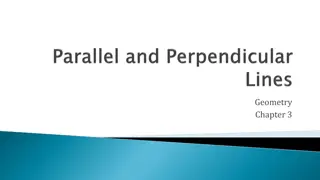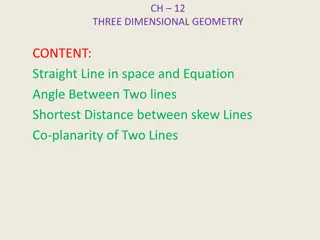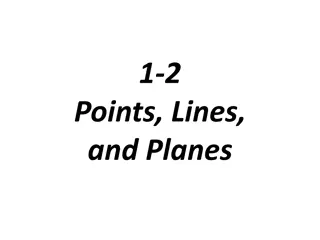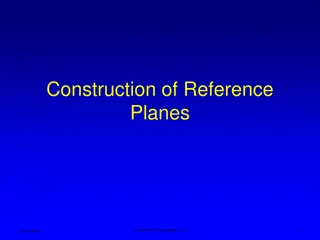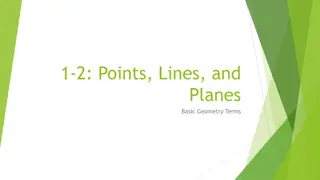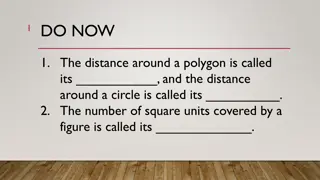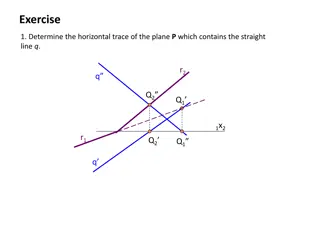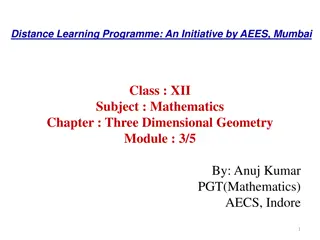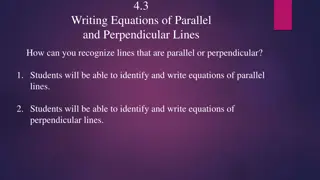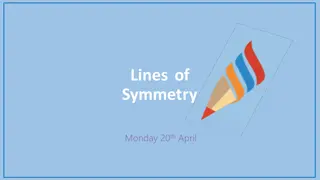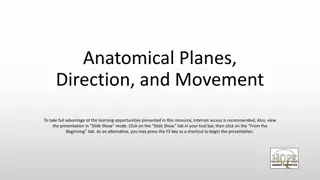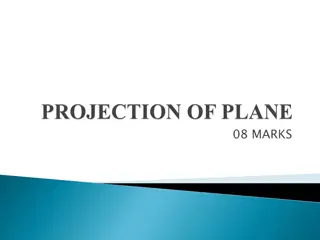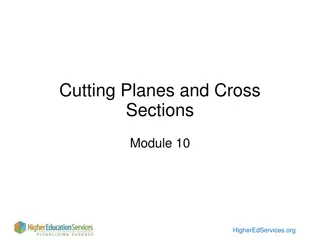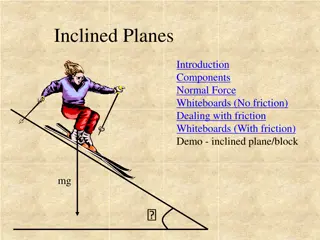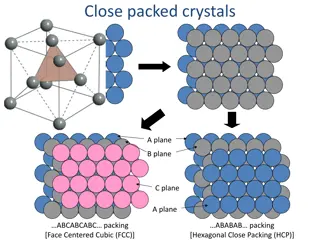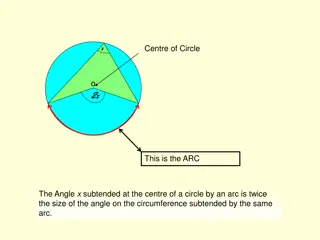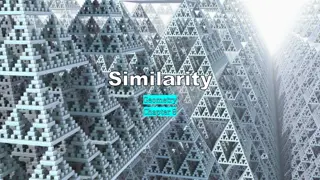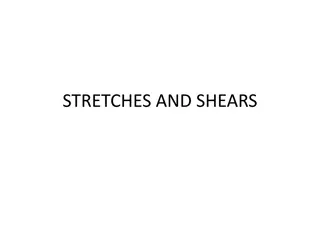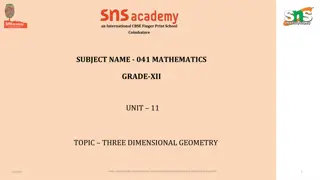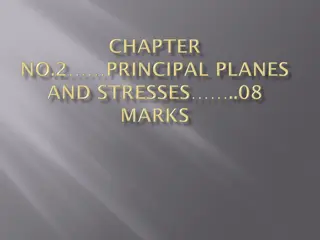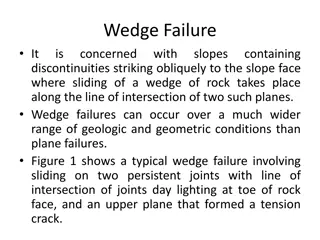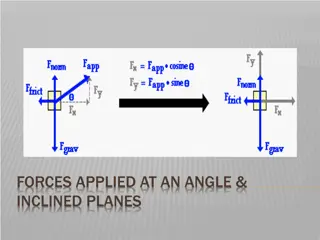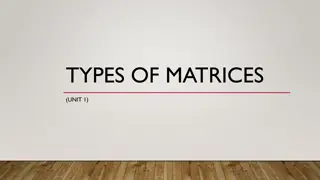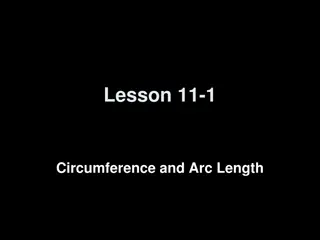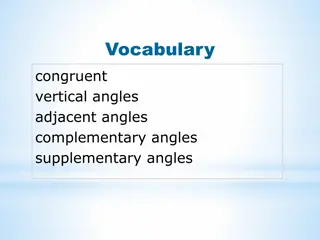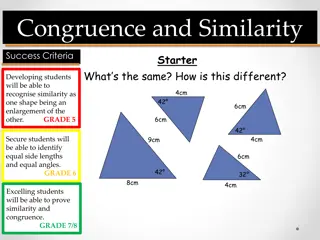Understanding Skew Lines and Planes in 3D Geometry
Explore the concepts of skew lines, parallel lines, perpendicular lines, and planes in 3D geometry through real-life examples and equations. Learn about the shortest distance between skew lines and solve problems related to their applications.
Download Presentation

Please find below an Image/Link to download the presentation.
The content on the website is provided AS IS for your information and personal use only. It may not be sold, licensed, or shared on other websites without obtaining consent from the author. Download presentation by click this link. If you encounter any issues during the download, it is possible that the publisher has removed the file from their server.
E N D
Presentation Transcript
SKEW LINES BY K. SHALINI LECTURER IN MATHEMATICS SKR & SKR COLLEGE FOR WOMEN, KADAPA
OBJECTIVES Introduction Oblique lines Parallel lines Perpendicular lines Skew lines : 3d Geometry : in real life examples Difference between parallel lines and skew lines Shortest Distance between the skew lines Problems on skew lines Applications conclusion
INTRODUCTION Point :- Indicates a location and has nosize Segment :- Part of a line between two points Plane:- Represented by a flat surface that extends forever in all directions Line :- Represented by a straight path that extends in two opposite directions without end and has no thickness. A line contains infinitely many points.
PLANES Plane:- Plane is a flat two dimensional surface with no thickness, that extends infinitely. It can be recognized by three points on a surface that is not on the same line. Real Life examples: A piece of paper. Wall. White-board. A note card. Desktop.
EQUATION OF A PLANE IN 3D A plane in three-dimensional space hasthe equation ax+by+cz+d=0 where at least one of the numbers a, b, and c must be non-zero. A plane in 3D coordinate space is determined by a point and perpendicular to the plane. The equation of a plane through a point A=(x1,y1,z1) whose normal vector n=(a,b,c) is a(x x1)+b(y y1)+c(z z1)=0 a vector that is
EXAMPLE: If a plane is passing through the pointA=(1,3,2) and has normal vector n =(3,2,5), then what is the equation of the plane? The equation of the plane which passes through A=(1,3,2) and has normal vector n=(3,2,5) is a(x x1)+b(y y1)+c(z z1)=0 3(x 1)+2(y 3)+5(z 2)=0 3x 3+2y 6+5z 10=0 3x+2y+5z 19=0
LINES Line: When two points extend infinitely in the opposite direction then it is called a line. The line is denoted by showing two arrowheads going in the opposite direction. Real-Life Examples: Time. Lines of latitude and longitude. The center-line on a highway. The Equator.
EQUATION OF LINE IN 3D In three dimensional geometry, a straight line is defined as the intersection of two planes. So general equation of straight line is stated as the equations of both plane together i.e. general equation of straight line is a1x + b1y + c1z + d1 = 0, a2x + b2y + c2z + d2 =0 (1) So, equation (1) represents straight line which is obtained by intersection of two planes.
DIFFERENT FORMS OF LINES Symmetrical Formof a line: Equationof straight line passing through point P (x1, y1, z1) and whose direction cosinesare (l, m, n) is (x x1)/l = (y y1)/m = (z z1) / n. Equationof straight line passing through two points P (x1, y1, z1) and Q (x2, y2, z2)is x x1 / x2 x1 = y y1 / y2 y1 = z z1 / z2 z1 Section formula: If P(x, y) divides the line joiningA(x1, y1) and B(x2, y2) in the ratio of m:nthen, x = (mx2 + nx1)/ (m+n) and y = (my2 + ny1)/ (m+n) Interceptform: If a straight line makes an intercept of say a and b on x and y axis respectively, then the equation of the straight line is given as x/a + y/b = 1
EQUATION OF LINE The equation of a line through a point(2,3,4) (1,2,3) is given by the formula x x1 / x2 x1 = y y1 / y2 y1 = z z1 / z2 z1 X-2/1-2=y-3/2-3=z-4/3-4 X-2/-1=y-3/-1=z-4/-1 X-2=y-3=z-4
PARALLEL LINES Parallel Lines: When two lines extend together by maintaining the themselves which never share an intersecting point, then they are called parallel lines. Real-Life Examples: Railway tracks. The lines of runningtracks. Lines on a road. The opposite sides of a book. same distance between
Parallel lines are two lines that are always the same distance apart and never touch. In order for two lines to be parallel, they must be drawn in the same plane, a perfectly flat surface like a wall or sheet of paper. Here, three set of parallel lines have been shown - vertical, diagonal and horizontal parallellines. Sides of various shapes are parallel to each other. Parallel lines are represented with a pair of vertical lines between the names of the lines, such as PQ XY.
We can see parallel lines in a zebra crossing, the lines of notebook and in railway tracks around us. Each line can have many parallellinesto it. Parallel lines canbe extendedindefinitely,with out them intersecting at anypoint.
SKEW LINES In three-dimensionalgeometry, skew linesare two linesthat do not intersect and are notparallel. Skew lines are straight lines in a threedimensionalform which are not paralleland do not cross. An example of skew lines are the sidewalk in front ofa houseand a linerunningacrossthetop edge of a side of a house. Lines ab and cd are skewlines.
Example: A street sign is an example of skew lines in real life. Two street signs, they do not intersect, they are not parallel, and the lines are straight. The sign contains a pair of skew lines because the two lines do not intersect and are not parallel or coplanar (one line is in blue and one line is in green). Street signs are very important to drivers. Street signs give people sense of direction and where oneis located.
Since skew lines have to be in different planes, we need to think in 3-D to visualize them. However, it is often difficult to illustrate three-dimensional concepts on paper or a computer screen. Let's look at a few examples to help you see how skew linesappearin diagrams.
Difference between Parallel and Skew lines Two or more lines are parallel when they lie in the same plane and never intersect. ... Skew lines are lines that are in different planes and intersect. never The difference between parallel lines and skew lines is parallel lines lie in the same plane while skew lines lie in different planes.
Skew Lines in 3-D Geometry In three-dimensional geometry, we are always dealing with objects in the three-dimensional Cartesian space. One of the key elements of three-dimensional geometry is the straight line, also sometimes simply referred to as a line. There can be various ways in which two lines are related in the three-dimensional space. Our focus in the following section shall be on skew lines. The objective is to find out how to measure the distance between such skew lines. Note that in case the two skew lines are intersecting, the shortest distance between them must necessarily be zero. The other cases are that of parallel lines and skew lines. Skew Lines are basically, lines that neither intersect each other nor are they parallel to each other in the three-dimensionalspace.
SHORTESTDISTANCEBETWEENSKEWLINES The shortest distance between skew lines is equal to the length of the perpendicular betweenthe two lines. Look at the figure below. You can see two lines from the three- dimensional Cartesian plane. As is evident from the figure, the shortest distance between the lines is one which is perpendicular to both the lines as compared to any other lines that joins these two skewlines.
We will now move on to how the shortest distance i.e. the length of the perpendicular to two skew lines can be calculatedin Vectorform and in Cartesianform.
VectorForm We shall consider two skew lines, say l1 and l2 and we are to calculate the distance between them. The equations of the linesare: r 1=a 1+t.b 1 r 2=a 2+t.b 2 P = a 1 is a point on line l1 and Q = a 2 is a point on line l1. The vector from P to Q will be a 2 a 1. The unit vector normal to both the lines is given by, (b 1 b 2)/|b 1 b 2| Then, the shortest distance between the two skew lines will be the projection of PQ on the normal, which is given by d=|(a 2 a 1).(b 1 b 2)|/|b 1 b 2| where d measures the distance or the length of the perpendicular.
Cartesian Form Let us consider two lines whoseequations are given by: (x x1)/a1=(y y1)/b1=(z z1)/c1 (x x2)/a2=(y y2)/b2=(z z2)/c2 Then the shortest distance between these lines, when calculatedusing the Cartesian equations, is given by
Solved Example Question: Find the shortest distance between thelines whose equations are: r 1=i +j + (2i j +k ) r 2=2i +j k + (3i 5j +2k ) Answer: We shall compare the given equations withthe standard form a1=i +j ,b1=2i j +k a2=2i +j k ,b2=3i 5j +2k So, we can find the shortest distance as : d=|[(2i j +k ) (3i 5j +2k )].(i k )|/|(2i j +k ) (3i 5j +2k )| = | 3 0 + 7 | / (59)1/2 = |10| / (59)1/2 is the shortest distance between the given lines.
SHORTEST DISTANCE BETWEEN TWO LINES IN SYMMETRICAL FORM
SHORTEST DISTANCE BETWEEN LINES(SYMMETRICAL AND UN SYMMETRICAL)
SHORTEST DISTANCE BETWEEN LINES(TWO UNSYMMETRICAL LINES)
CONCLUSIONS If two lines are skew, they do not lie in the same plane, because any two lines in the same plane, either intersect or parallel to each other. Skew lines exist only in three or more dimensions.


